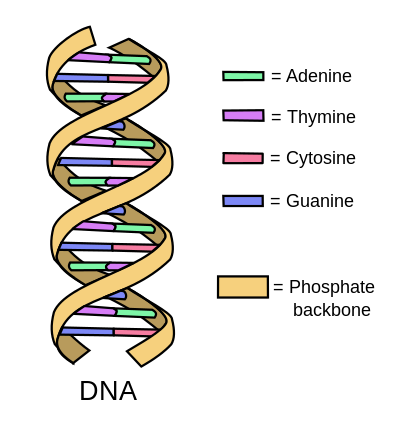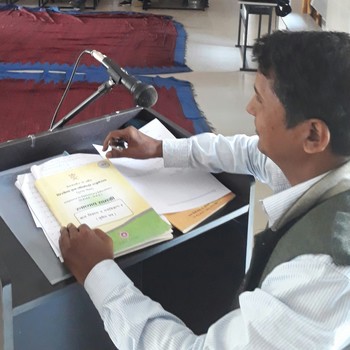What is dna?
7 Answers
Deoxyribonucleic Acid is the meaning of it. It is a nucleic acid that is the carrier of genetic information.
Explanation:
DNA are the letters of deoxyribonucleic acid.
All life on earth uses this nucleic acid as the genetic code.
A nucleic acid is a polynucleotide. A polynucleotide consists of three basic units: a phosphate group, a 5 carbon sugar (pentose), and a nitrogenous base. The five carbon sugar is deoxyribose. Since a polynucleotide chain, the phosphate and deoxyribose units are repetitive, the variation is provided by the nitrogenous bases.
There are four bases: adenine, guanine, cytosine, and thymine.
Both adenine and guanine are purines which have a double ring structure. Cytosine and thymine are pyramidines which consist of a single ring structure.
The DNA molecule is double helix, a spiral shaped ladder. The upright or backbone of the ladder is made of alternating pentose and phosphate groups held together by covalent bonds. The rungs or steps of the ladder consist of the bases. These bases are joined to the pentose sugars with covalent bonds. Adenine pairs with thymine using two hydrogen bonds and cytosine pairs with guanine using three hydrogen.
 )
)
The genetic code is determined by the linear sequence of the bases.
For example the sequence of adenine guanine thymine does not carry the same message as guanine thymine adenine.
The code is arranged in triplet form which codes for RNA which in turn codes for amino acids which form the basis of proteins.
DNA, or deoxyribo nucleic acid, is the structure that codes for the genetic instructions for the development and functioning of an organism. Every organism's DNA is different, and is made up of two strands woven into a double helix shape.
DNA is composed of four nitrogen-containing nucleobases; A, T, G, and C, or Adenosine, Thymine, Guanine, and Cytosine. Each base pairs up with another base to form complimentary base pairs, and it is these pairs that form the basis of DNA, as well as a sugar- deoxyribose- and a phosphate group.
Proteins and enzymes are also composed of the four bases, and it is these proteins and enzymes that allow the organs in the body to function. For example, the enzymes in the stomach, which are specially designed to withstand the acidic conditions -about pH 2- so that they can digest the food that passes through the digestive system.
DNA stands for deoxyribonucleic acid. DNA is considered the blueprints for our cells and our body. It contains all of the genetic information that the body needs to grow.
Explanation:
DNA stands for deoxyribonucleic acid. DNA is considered the blueprints for our cells and our body because it contains all of the genetic information that the body needs to grow.
Activities of DNA
DNA goes through mitosis to create sister cells that are identical to the parent. Mitosis helps our bodies grow, our cuts to regenerate.
DNA also goes through meiosis where our haploid gametes (sex cells) make 4 different cells. This is used when we are reproducing to create offspring.
There are a few components that make the DNA including nitrogenous bases (Adenine and Thymine, Cytosine and Guanine) and the phosphate backbone.

DNA is the self-replicating material in almost every living organism that carries genetic information that codes for every function of the cell and/or body (of a multi-cellular organism).
Explanation:
DNA or deoxyribonucleic acid is the substance of chromosomes which form the genetic material in almost every living organism.
It is a helical (twisted around itself) double-stranded structure made up of nucleotides comprising a phosphate group, a sugar group and a nitrogen base. There are four nitrogen bases which are always in pairs: adenine and thymine, guanine and cytosine.
The phosphate and sugar groups form the chain or strands while the nitrogen bases connect the strands.
It is the sequences of nitrogen bases that form genes that code for particular traits or characteristics.
DNA is genetic material.
Explanation:
- The full form of DNA is deoxyribose nucleic acid. It is helical structure of two strands. The two interlinked strands are joined by hydrogen bonds.
- DNA strands synthesize mRNA, which helps in protein synthesis. The proteins are biocatalyst. Thank you
DNA is a long molecule in cells which codes for the building of different molecules.
Explanation:
DNA, or DeoxyriboNucleic Acid, is a long molecule in all cells. It stores genetic material. DNA is composed of three parts. There is a sugar (deoxyribose), a phosphate group, and a nitrogen base.
There are four nitrogen bases, Adenine, Guanine, Cytosine, and Thymine. They can be arranged in different orders to code for various polypeptides (proteins) and other structures the body needs.
DNA is double-helical. It is made of two interlocking spirals.
In eukaryotic cells, DNA is wrapped around a centrosome to form a chromosome. The chromosomes are located in the nucleus. In prokaryotic cells, the DNA is not located in the nucleus.
See below
Explanation:
Deoxyribonucleic acid or DNA is a molecule that contains the genetic materials of an organism.
DNA has bases, these bases are thymine, guanine and cytosine. They bind to each other to form the base of DNA and the shape has to be their complementary shape, otherwise they don't bind.
Thymine binds with adenine, cytosine with guanine. Each base is attached to sugar and phosphate group, this is then called nucleotides. The nucleotides are arranged into two long strands to form the DNA/double helix.
 )
)







